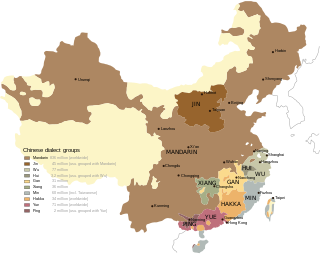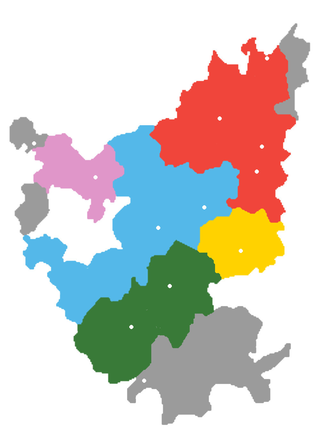Related Research Articles
Hanyu Pinyin, or simply pinyin, is the most common romanization system for Standard Chinese. In official documents, it is referred to as the Chinese Phonetic Alphabet. It is the official system used in China, Singapore, Taiwan, and by the United Nations. Its use has become common when transliterating Standard Chinese mostly regardless of region, though it is less ubiquitous in Taiwan. It is used to teach Standard Chinese, normally written with Chinese characters, to students already familiar with the Latin alphabet. The system makes use of diacritics to indicate the four tones found in Standard Chinese, though these are often omitted in various contexts, such as when spelling Chinese names in non-Chinese texts, or when writing non-Chinese words in Chinese-language texts. Pinyin is also used by various input methods on computers and to categorize entries in some Chinese dictionaries. Hànyǔ literally means 'Han language'—meaning, the Chinese language—while pinyin literally means 'spelled sounds'.

Wu is a major group of Sinitic languages spoken primarily in Shanghai, Zhejiang Province, and the part of Jiangsu Province south of the Yangtze River, which makes up the cultural region of Wu. Speakers of various Wu languages sometimes labelled their mother tongue as Shanghainese when introduced to foreigners. The Suzhou dialect was the prestige dialect of Wu as of the 19th century, but had been replaced in status by Shanghainese by the turn of the 20th century. The languages of Northern Wu are mutually intelligible with each other, while those of Southern Wu are not.
The Shanghainese language, also known as the Shanghai dialect, or Hu language, is a variety of Wu Chinese spoken in the central districts of the city of Shanghai and its surrounding areas. It is classified as part of the Sino-Tibetan language family. Shanghainese, like the rest of the Wu language group, is mutually unintelligible with other varieties of Chinese, such as Mandarin.
Guangdong Romanization refers to the four romanization schemes published by the Guangdong Provincial Education Department in 1960 for transliterating Cantonese, Teochew, Hakka and Hainanese. The schemes utilized similar elements with some differences in order to adapt to their respective spoken varieties.
Peng'im is a Teochew dialect romanization system as a part of Guangdong Romanization published by Guangdong Provincial Education Department in 1960. The tone of this system is based on the Swatow dialect. The system uses the Latin alphabet to transcript pronunciation and numbers to note tones.

Hainanese, also known as Qiongwen or Qiongyu, is a group of Min Chinese varieties spoken in the far southern Chinese island province of Hainan and regional Overseas Chinese communities such as in Singapore and Thailand, particularly by the In the classification of Yuan Jiahua, it was included in the Southern Min group, being mutually unintelligible with other Southern Min varieties such as Hokkien–Taiwanese and Teochew. In the classification of Li Rong, used by the Language Atlas of China, it was treated as a separate Min subgroup. Hou Jingyi combined it with Leizhou Min, spoken on the neighboring mainland Leizhou Peninsula, in a Qiong–Lei group. "Hainanese" is also used for the language of the Li people living in Hainan, but generally refers to Min varieties spoken in Hainan.

The Sinitic languages, often synonymous with the Chinese languages, are a group of East Asian analytic languages that constitute a major branch of the Sino-Tibetan language family. It is frequently proposed that there is a primary split between the Sinitic languages and the rest of the family. This view is rejected by a number of researchers but has found phylogenetic support among others. The Macro-Bai languages, whose classification is difficult, may be an offshoot of Old Chinese and thus Sinitic; otherwise Sinitic is defined only by the many varieties of Chinese unified by a shared historical background, and usage of the term "Sinitic" may reflect the linguistic view that Chinese constitutes a family of distinct languages, rather than variants of a single language.
A checked tone, commonly known by the Chinese calque entering tone, is one of the four syllable types in the phonology of Middle Chinese. Although usually translated as "tone", a checked tone is not a tone in the phonetic sense but rather a type of syllable that ends in a stop consonant or a glottal stop. Separating the checked tone allows -p, -t, and -k to be treated as allophones of -m, -n, and -ng, respectively, since they are in complementary distribution. Stops appear only in the checked tone, and nasals appear only in the other tones. Because of the origin of tone in Chinese, the number of tones found in such syllables is smaller than the number of tones in other syllables. Chinese phonetics have traditionally counted them separately.
The SASM/GNC/SRC romanization of Standard Tibetan, commonly known as Tibetan pinyin or ZWPY, is the official transcription system for the Tibetan language in China. It is based on the pronunciation used by China National Radio's Tibetan Radio, which is based on the Lhasa dialect. It has been used within China as an alternative to the Wylie transliteration for writing Tibetan in the Latin script since 1982.
Wenzhounese, also known as Oujiang, Tong Au or Au Nyü, is the language spoken in Wenzhou, the southern prefecture of Zhejiang, China. It is the most divergent division of Wu Chinese, with little to no mutual intelligibility with other Wu dialects or any other variety of Chinese. It features noticeable elements in common with Min Chinese, which is spoken to the south in Fujian. Oujiang is sometimes used as the broader term, and Wenzhou for Wenzhounese proper in a narrow sense.
Qian Nairong is a Chinese linguist. He received a master's degree in Chinese from Fudan University in 1981. He is a professor and the head of the Chinese Department at Shanghai University. He is a researcher and advocate of Shanghainese, a dialect of Wu Chinese.
Taihu Wu (吳語太湖片) or Northern Wu (北部吳語) is a Wu Chinese language spoken in much of the southern part of the province of Jiangsu, including Suzhou, Wuxi, Changzhou, the southern part of Nantong, Jingjiang and Danyang; the municipality of Shanghai; and the northern part of Zhejiang province, including Hangzhou, Shaoxing, Ningbo, Huzhou, and Jiaxing. A notable exception is the dialect of the town of Jinxiang, which is a linguistic exclave of Taihu Wu in Zhenan Min-speaking Cangnan county of Wenzhou prefecture in Zhejiang province. Speakers in regions around Taihu Lake and Hangzhou Bay, are the largest population among all Wu speakers. Taihu Wu dialects such as Shanghainese, Shaoxing and Ningbo are mutually intelligible even for L2 Taihu speakers.

Guzhang County is a county of Hunan Province, China. The county is the 2nd least populous administrative unit of the counties or county-level cities in the province, it is under the administration of Xiangxi Autonomous Prefecture.
Bbánlám Uē Pìngyīm Hōng'àn, Bbánlám pìngyīm, Minnan pinyin or simply pingyim, is a romanization system for Hokkien Southern Min, in particular the Amoy (Xiamen) version of this language. This romanization system was devised at Xiamen University and first published in the 1982 普通話閩南方言詞典.
Sichuanese Pinyin (Si4cuan1hua4 Pin1yin1; simplified Chinese: 四川话拼音; traditional Chinese: 四川話拼音; pinyin: Sìchuānhuà pīnyīn), is a romanization system specifically designed for the Chengdu dialect of Sichuanese. It is mostly used in selected Sichuanese dictionaries, such as the Sichuan Dialect Dictionary, Sichuan Dialect's Vocabulary Explanation, and the Chengdu Dialect Dictionary. Sichuanese Pinyin is based on Hanyu Pinyin, the only Chinese romanization system officially instructed within the People's Republic of China, for convenience amongst users. However, Hanyu Pinyin is unable to match the phonology of Sichuanese with complete precision, especially in the case for the Minjiang dialect, as there are many differences between Sichuanese and Standard Chinese in phonology.

Old Xiang, also known as Lou-Shao, is a conservative Xiang Chinese language. It is spoken in the central areas of Hunan where it has been to some extent isolated from the neighboring Chinese languages, Southwestern Mandarin and Gan languages, and it retains the voiced plosives of Middle Chinese, which are otherwise only preserved in Wu languages like Shanghainese. See Shuangfeng dialect for details. Mao Zedong was a speaker of Old Xiang with his native Shaoshan dialect.
The Shaoxing dialect is a Wu dialect spoken in the city of Shaoxing more specifically in the city center of Yuecheng and its surrounding areas. It is a representative Wu dialect with a tripartite distinction on voiced stop initials and a textbook register split with each of the four tonal categories of Middle Chinese being divided into upper and lower registers. Within Wu, it is classified as a Northern Wu dialect belonging to the Taihu division within which it is classified under the Linshao subdivision (臨紹小片/临绍小片).
The Tiantai dialect, also known as Tiantaihua is a regiolect of Wu Chinese in the Taizhou Wu dialect group. It is spoken in Tiantai County, Taizhou, Zhejiang province, China.
The Fuzhou Transliteration Scheme refers to the romanization scheme published in 1994 for the Fuzhou Dialect Dictionary, romanizing the Fuzhou dialect. It does not explicitly state the tones.
Northern Wu, or Taihu Wu, is the largest subbranch of Wu Chinese, and is spoken in Shanghai, southern Jiangsu, and northern Zhejiang. These languages are noted for their extremely high number of vowels, even compared to some Germanic languages, and highly complex tone sandhi. This article will use Wugniu and IPA for transcription.
References
- ↑ – Wu chinese (Tones)
- ↑ "Shanghainese Romanization". 吴语协会. 吴语协会 (Wu Chinese Society). Retrieved 15 May 2024.
- ↑ 唐骋华; 孔亮 (19 August 2007). "都市年轻人为传承上海方言走到一起". Youth Daily [青年报] (in Chinese). Shanghai. Archived from the original on 29 June 2013.
- ↑ "吳語拼音草案" (in Chinese). Archived from the original on 4 March 2010.
- ↑ Qian, Nairong (6 December 2006). "首届国际上海方言学术研讨会审定上海话拼音方案". 北大中文论坛 (in Chinese). Archived from the original on 16 February 2021.
- ↑ Qian, Nairong (August 2007). 上海话大词典. Shanghai: 上海辞书出版社. ISBN 9787532622481.
- ↑ Qian, Nairong (September 2013). 新上海人学说上海话. Shanghai: 上海大学出版社. ISBN 9787567108820.
- ↑ Ding, Dimeng (January 2015). 学说上海话. Shanghai: 上海科技技术文献出版社. ISBN 9787543964181.
- 1 2 刑雯芝 (3 February 2018). Shíyòng Sūzhōuhuà实用苏州话[Practical Suzhou Dialect] (in Simplified Chinese, Wu, and English). Peking University Press. ISBN 978-7-301-18998-6.